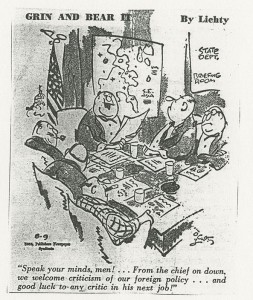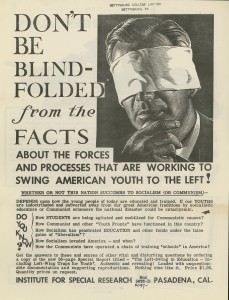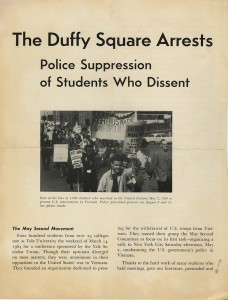
This political cartoon by George Lichty depicts a State Department official threatening to fire any subordinates critical of the nation’s foreign policy decisions. The cartoon functions as political commentary, suggesting that even those in powerful positions had doubts about the war but weren’t free to express them.
The Johnson and Nixon administrations both took measures to silence and erode youth activism on college campuses, as did local law enforcement officials, private citizens, and some college administrators. President Lyndon B. Johnson verbally denounced protesters and ordered the CIA to engage in domestic spying on student groups. President Richard Nixon initially dismissed student protesters as inconsequential, but eventually made a public call for the so-called “silent majority” in order to drown out the voices of antiwar sentiment. The White House’s hard stance towards opposition can be seen in this George Lichty cartoon highlighting its inability to tolerate criticism of the war even from high officials within the State Department, whose concerns were generally expressed in ways that were much less confrontational than the students’.

As fear of Communism continued to be widespread through the nation, conservative groups such as the Institute for Special Research warned of a left-wing political shift occurring in youth movements.
Many leading supporters of the war considered dissenters at home an almost equal threat to that of their enemies overseas. Conservative commentators like Phillip Abbot Luce and William F. Buckley, Jr. often published their suspicions that communist agents had infiltrated the youth movements, severely undermining the efforts of students. This flyer from the Institute for Special Research makes many assertions about how this “infiltration” occurred. Literature like this tapped into the American public’s fear of Communism by attempting to paint a picture of student activists as “Reds.”

Student protests were often suppressed by the police, as seen in this pamphlet describing the arrests of Yale students at Duffy Square. On May 2, 1964, four hundred students from over twenty-five colleges met in Times Square to condemn the United States government’s policy in Vietnam.
As early as 1964, student protesters were suppressed by local governments. On May 2, 1964, police broke up a demonstration in Duffy Square in New York City. While this incident remained relatively peaceful, others did not. The infamous May 4, 1970 incident at Kent State University was in many ways the culmination of the government’s response toward student protests. After rioting broke out on the university campus and across the surrounding downtown area in response to the expansion of the war into Cambodia, National Guardsmen fired into a crowd of student protesters, killing four and wounding nine others. In his first official comment on the shooting, President Richard Nixon implied that the students got what they deserved. Four days later, roughly 200 construction workers took responding to student protest into their own hands, violently attacking students in New York City who were protesting the events at Kent State.
Despite facing large scale opposition from many of their fellow Americans, student activists persisted in their opposition to the war in Vietnam. What began as frustration with U.S. involvement in Vietnam morphed into a wave of student demonstrations with the help of a counterculture movement that challenged authority and social norms. While students often engaged in controversial activities to prove their point and were strongly criticized for these actions, the nation heard their voices. Eventually, public opinion turned against the continued war in Vietnam to the point that a substantial percentage of influential politicians were running on antiwar platforms by the early 1970s. In the wake of mounting casualties and widespread erosion of public support for the war, the United States ultimately withdrew its troops from Vietnam in 1973. Saigon, the capital of South Vietnam, fell to the North Vietnamese in April 1975.
